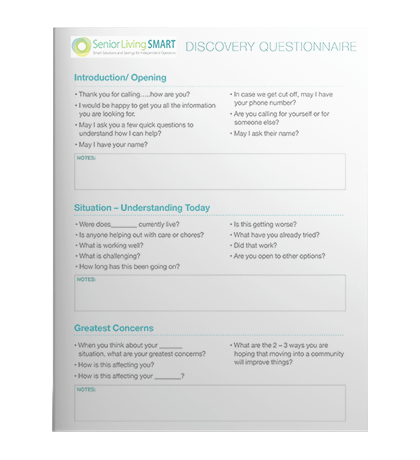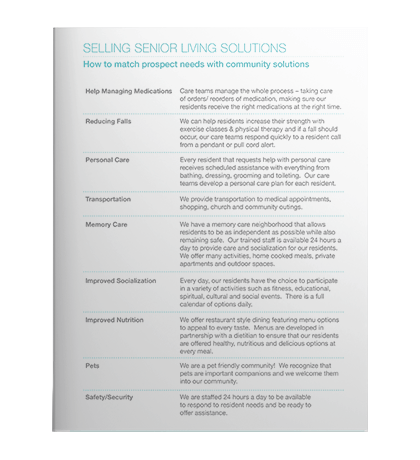Senior Living Sales Strategies: How to Handle the Initial Phone Inquiry
When it comes to senior living sales strategies, taking an inquiry call seems simple enough. The phone rings. The person on the other end is reaching out to get information about senior living. Our job is to qualify the prospect and, if appropriate, advance them to a next step.
Simple, right? Nope!
Calls can take many different paths and senior living sales pros have to be prepared, flexible, and intuitive to be successful. Below are do’s and don’ts to keep in mind during this very important step.
1. Senior living sales strategy: Do use a discovery form or questionnaire to capture information.
Over the years, I’ve tried many different discovery forms, including scripted ones and others organized in qualifying themes with sample questions and a box for notes. The problem is that the conversations are not linear and prospects tend to jump around while telling their story. But that’s OK. A messy form is better than NO form.
So figure out what works best for you and stick with it. Whatever you do, don’t wing it! If you need a form, download the one we’ve created (it’s free).
2. Senior living sales strategy: Don’t make it sound like an interrogation.
Listening to hundreds of mystery shops, I’m reminded of how cold it sounds to start a conversation with a litany of informational questions: name, phone, email, address, zip, loved one’s name and age, and the ubiquitous “How did you hear about us?”
Remember, it takes a lot of courage to pick up the phone and call a community. Often, prospects are in crisis mode and what they need is compassion, empathy, and someone who is willing to listen and help. (Keep in mind that it’s quite possible the person has already perused your senior living website as well. So this “first call” isn’t necessarily their first engagement with your community.)
At the beginning of the call, the sales person should only ask for the caller’s name, phone number (in case you get disconnected), and the name and relationship of who they are calling for (so you can personalize the conversation). Then, let the person tell you his or her story. Wait until the end of the conversation to finish gathering all the contact and referral source information.
3. Senior living sales strategy: Do ask these five types of questions (and hold off on pushing for a tour).
Good discovery leads to higher conversions-to-tours and move-ins. Don’t rush the process. Trying to book a tour without knowing anything about the situation is sales malpractice.
Here are the five types of questions you should always ask:
- Situational. Where is the prospect living, are they getting any help from family or agencies, what is working and what is not?
- Greatest Concerns. What are they worried about, how is that affecting everyone, how would moving into a community help?
- Motivations. Why now, what has changed, what does the person want and need, what routines are important to maintain, how will they choose the right community, who will be involved and what are their roles?
- Life Story. What are their favorite interests, hobbies, foods, and so forth? What did they do for work? Do they have children? Grandchildren?
- Financial. Do they have a budget and/or will they qualify for any funding solutions, such as Veterans Aid & Attendance, life insurance conversion, or long-term care insurance?
4. Senior living sales strategy: Do take the time to match a prospect’s wants/needs with specific solutions.
After listening to the story and understanding their situation, you should match their specific needs with community solutions. Avoid “feature dumping,” which simply provides a laundry list of everything the community offers and ignores whether any of it is relevant to the prospect.
Instead, opt for “needs matching,” which involves listening to the prospect’s desires and explaining how living at the community will fulfill those desires and needs. Download our “needs matching” sheet.
5. Senior living sales strategy: Don’t hang up without a next step.
Effective discovery results in a scheduled next step that is date and time specific. If you can’t put it on a calendar, then you can’t consider it a next step or advance.
Always have a main “advance” planned and a back-up “advance” in case the first one is rejected. Sample advances include a scheduled tour, attendance at an upcoming lunch or an event, an appointment with someone who can help with funding solutions, a scheduled home visit or assessment, or attendance at a support group.
If all else fails, ask for mailing and email addresses to send out newsletters/activity calendars or invitations to events.
Need help with this and other senior living sales strategies?
We love working with marketing and sales teams. Our approach helps make everyone’s jobs easier. Let’s chat about your needs!
Download our eBook
for marketers looking to get the most out of inbound phone calls
See real-time, working community examples of integrating these technology solutions helped to complement existing sales team.





Leave a Reply
Want to join the discussion?Feel free to contribute!